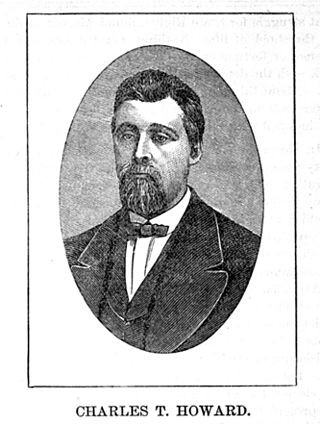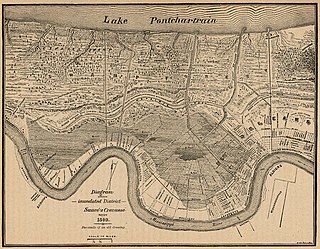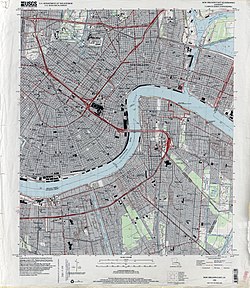Elmwood is a census-designated place (CDP) in Jefferson Parish, Louisiana, United States, within the New Orleans–Metairie–Kenner metropolitan statistical area. The population was 4,635 at the 2010 census, and 5,649 in 2020. Elmwood was part of neighboring Jefferson's census area from 1960 to 1990. The ZIP Code serving Elmwood is 70123.

Jefferson is a census-designated place (CDP) in Jefferson Parish, Louisiana, United States, on the north side of the Mississippi River. Jefferson is part of the New Orleans–Metairie–Kenner metropolitan statistical area. The population was 11,193 at the 2010 census, and 10,533 in 2020. It is often known by locals as "Old Jefferson", but should not be confused with Old Jefferson in East Baton Rouge Parish, Louisiana.

Kenner is a city in the U.S. state of Louisiana. It is the most populous city in Jefferson Parish, and is the largest incorporated suburban city of New Orleans. The population was 66,448 at the 2020 census, making it the sixth-most populous city in Louisiana.

Metairie is a census-designated place (CDP) in Jefferson Parish, Louisiana, United States, and is part of the New Orleans metropolitan area. With a population of 143,507 in 2020, Metairie is the largest community in Jefferson Parish and was the fifth-largest CDP in the United States. It is an unincorporated area that would have been Louisiana's fourth-largest city behind Shreveport if incorporated.

Saint Louis Cemetery is the name of three Catholic cemeteries in New Orleans, Louisiana. Most of the graves are above-ground vaults constructed in the 18th and 19th centuries.
Ruth Ann Udstad Fertel was a Louisiana businesswoman, best known as the founder of Ruth's Chris Steak Houses, which was founded in 1965.

Grace King High School was a public high school located in Metairie, unincorporated Jefferson Parish, Louisiana, United States. It was a part of the Jefferson Parish Public Schools and served portions of Metairie and Kenner.

Fair Grounds Race Course, often known as New Orleans Fair Grounds, is a thoroughbred racetrack and racino in New Orleans, Louisiana. It is operated by Churchill Downs Louisiana Horseracing Company, LLC.

Greenwood Cemetery is a historic rural cemetery in New Orleans, Louisiana. The cemetery was opened in 1852, and is located on City Park Avenue in the Navarre neighborhood. The cemetery has a number of impressive monuments and sculptures. It is one of a group of historic cemeteries in New Orleans.
The Louisiana Derby is a Grade II American Thoroughbred horse race run annually at the Fair Grounds Race Course in New Orleans, Louisiana. Run in late March, the race is open to horses, age three, willing to race 1+3⁄16 miles on the dirt. It currently offers a purse of $1,000,000.

Jean-Bernard Xavier Philippe de Marigny de Mandeville (1785–1868), known as Bernard de Marigny, was a French-Creole American nobleman, playboy, planter, politician, duelist, writer, horse breeder, land developer, and President of the Louisiana State Senate between 1822 and 1823.

Charles Turner Howard (1832–1885) was an American businessman notable for organizing the Louisiana State Lottery Company in 1869. This corporation bribed Louisiana lawmakers to enable it to stay in business, and the firm amassed a considerable fortune over the years while Howard led a controversial life. He died at age 53 after a fall from his carriage in Dobbs Ferry, New York, but his family continued his efforts at philanthropy and charitable giving.

Henry Augustine Tayloe of Oakley Plantation, Essex County, Virginia, later Gallion, Canebrake, Alabama, was an American planter, slaveholder, horse breeder and racer, and land speculator in the 19th century.

Bayou Metairie was a stranded distributary bayou that was located in present-day New Orleans, Louisiana, USA, and Jefferson Parish, Louisiana, USA, that extended from the area known as River Ridge to Bayou St. John. Bayou Metairie was filled in during the late 19th century and early 20th century although remnants of Bayou Metairie persist.

The Historic Cemeteries of New Orleans, New Orleans, United States, are a group of forty-two cemeteries that are historically and culturally significant. These are distinct from most cemeteries commonly located in the United States in that they are an amalgam of the French, Spanish, and Caribbean historical influences on the city of New Orleans in addition to limitations resulting from the city's high water table. The cemeteries reflect the ethnic, religious, and socio-economic heritages of the city. Architecturally, they are predominantly above ground tombs, family tombs, civic association tombs, and wall vaults, often in neo-classical design and laid out in regular patterns similar to city streets. They are at times referred to colloquially as “Cities of the Dead”, and some of the historic cemeteries are tourist destinations.
When Jefferson Davis died on December 6, 1889, his funeral was a major event in the United States, receiving front-page attention throughout the country. By the time of his death, Davis had become a transitional figure. He was the embodiment of the Old South, who lived long enough to be seen as emblematic of the New South. Davis's funeral and reburial is also symbolic of his problematic legacy as a leader of the Confederate States of America and its role in the perpetuation of slavery.
The Eclipse Race Course was the third formal thoroughbred horse racing track in New Orleans, Louisiana, founded in 1837 by Captain Yelverton Oliver, who owned the famous thoroughbred Richard of York; a native Virginian, who organized The New Orleans Jockey Club.
The Bascombe Race Course is a former thoroughbred horseracing track in Mobile, Alabama, built in 1836 that hosted The Mobile Jockey Club.

The Mobile Jockey Club was an American sporting organization founded prior to 1836 in Mobile, Alabama.

The Louisiana Jockey Club was an American sporting association founded in 1837 with the completion of the Carrollton Race Course, in New Orleans, Louisiana. Today this is the only remaining Thoroughbred Race Course of the old-line tracks, the others which have closed are the Metairie Race Course, the Eclipse Race Course, and the Jackson Race Course; it exists today as the Fair Grounds Race Course, where races are still held-making it the 2nd oldest continuous racing track in operation in the United States, after the Freehold Raceway and before the Saratoga Race Course.























